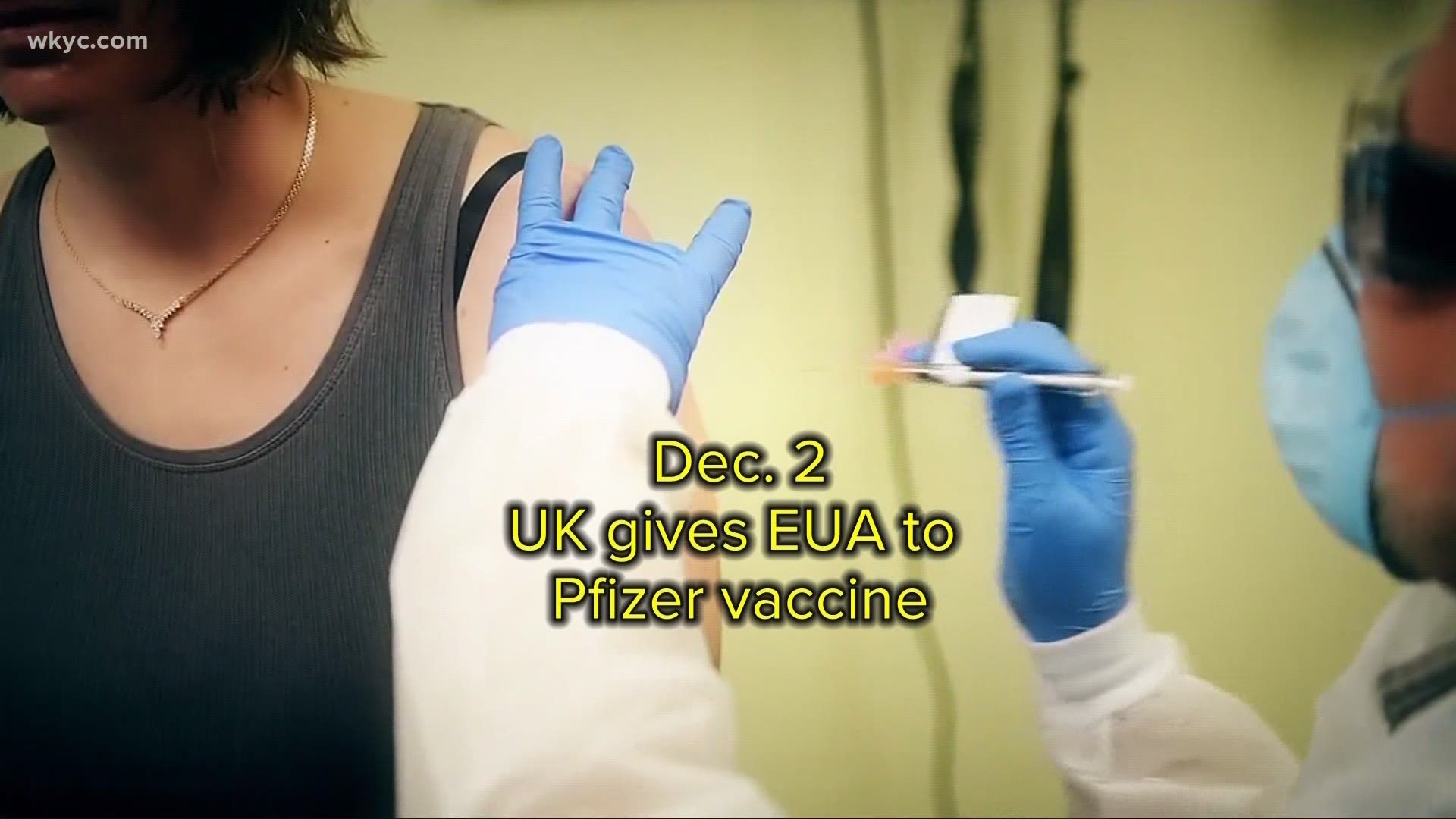CLEVELAND — It's been nearly a year that we've been dealing with the coronavirus pandemic. While there is light at the end of the tunnel, as we enter 2021, it's still far from over.
Here's a timeline from 3News Senior Health Correspondent Monica Robins as we look back at how the pandemic took shape in 2020.
December 31, 2019: The Wuhan China Health Commission announced it was dealing with a new type of coronavirus that caused pneumonia-like symptoms.
But by then, it was already spreading around the world.
January 21, 2020: The US confirmed its first case of coronavirus.
February 6: The CDC's coronavirus test kits arrived in Ohio. But they were flawed and not detecting the virus.
Local hospitals began retooling their labs for coronavirus testing while awaiting a more accurate method.
February 11: The virus was officially named Severe Acute Respiratory Syndrome Coronavirus 2 or SARS-CoV-2, because it's genetically related to the coronavirus that caused the 2003 SARS outbreak. But in a PR move to delineate the difference, the WHO called it COVID-19.
By now the virus was becoming headline news.
March 6: The Ohio Department of Health launched a call center (1-833-4-ASK-ODH) to answer questions.
People began stocking up on toilet paper hand sanitizer, soap, sanitizing wipes and masks. We were told to wash our hands, stay six feet apart and not touch our faces. Masks were needed for medical folks, not the general public.
March 9: Governor Mike DeWine declared a state of emergency after three people in Cuyahoga County are confirmed cases. That week, he began systematically limiting places where the virus could spread. Including nursing homes, schools and jails. Businesses would soon follow and hospitals were ordered to stop elective surgeries to preserve personal protective equipment for medical staff.
PPE became a hot commodity and states began a bidding war to get access to it.
Meanwhile the Governor and then-ODH director Dr. Amy Acton began daily news briefings, explaining the virus and reasons for health orders all meant to help us flatten the curve.
March 13: University Hospitals and Cleveland Clinic partnered to provide drive-through COVID-19 testing.
March 20: Ohio reported its first COVID death. The next day, Gov. DeWine announced Ohio's stay-at-home order.
Hospitals had an influx of COVID patients, many needing ventilators. Doctors were trying to learn more about the disease and its varying symptoms. It affected people in unpredicatable ways.
March 30: The FDA issues an Emergency Use Authorization for the malaria drug Hydroxychlorquine. That order would be rescinded in June after studies showed it didn't work.
April 3: The CDC tells us we should wear face masks.
April 10: The US became the country with the most COVID-19 deaths.
Later that month, the Governor announces Ohio schools will continue virtual learning for the rest of the school year.
May 1: Ohio began implementing its reopening plan and the FDA gives Emergency Authorization to the drug Remdesivir. It will be the first COVID drug to get official FDA approval in October.
May 14: The CDC advises some kids with COVID developed a multisystem inflammatory syndrome which lead to some deaths.
June 11: Acton resigned as the Ohio Department of Health director
June 15: The FDA revokes EUA for the malaria drug hydroxychloroquine after studies showed no benefit. The next day the steroid dexamethasone shows promise in reducing deaths.
July 22: DeWine announced a statewide mask mandate
At the end of July, Moderna and Pfizer begin recruiting thousands for the third phase of their vaccine study, including here in Northeast Ohio.
By mid-August, COVID becomes the third leading cause of death in the US.
As students return to school and college mass gatherings happen at bars and parties. Ohio cases rise to record levels by mid-October.
October 2: President Donald Trump announces he's been infected with COVID-19 and was given Remdesivir, dexamethasone and an experimental antibody treatment that will received FDA emergency approval two months later.
The announcement of President Trump's positive COVID-19 test came just days after a visit to Cleveland for the first presidential debate with Joe Biden.
By mid-November, Pfizer and Moderna say their vaccines are more than 90 percent effective. Both seek emergency approval.
December 2: The UK clears Pfizer's vaccine for emergency use and vaccinations begin. The FDA does the same on December 11th and vaccines arrive at Ohio hospitals by the 14th. Four days later, Moderna's vaccine also gets approval and vaccination efforts begin.
The pandemic fueled scientific breakthroughs but also proved basic public health measures work. But it's important to remember that the basic guidelines are going to stay with us for the next several months. Keep your masks handy and remember wash your hands.
More COVID-19/vaccine coverage:

